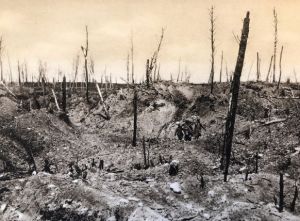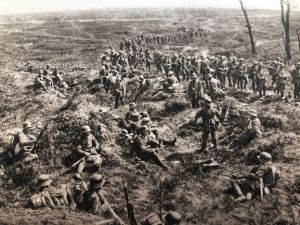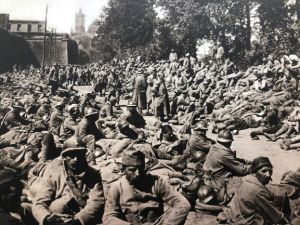TITEL (LFS01989) : Différence entre versions
| (Une révision intermédiaire par le même utilisateur non affichée) | |||
| Ligne 19 : | Ligne 19 : | ||
|lieux_ou_monuments=Laon; Kathedrale Notre-Dame Laon; Chemin des Dames | |lieux_ou_monuments=Laon; Kathedrale Notre-Dame Laon; Chemin des Dames | ||
|lieuTournage=49.56638, 3.6257 | |lieuTournage=49.56638, 3.6257 | ||
| + | |Resume_en=Family trip to France 1927 and visit to German and French war graves on the Chemin des Dames | ||
|Resume_de=Eine Reise nach Frankreich 1927 und Besuch der Kriegsgräber am Chemin des Dames | |Resume_de=Eine Reise nach Frankreich 1927 und Besuch der Kriegsgräber am Chemin des Dames | ||
| − | |||
|Description_de=Familie beim Baden in der Mosel; Ansichten der Kathedrale von Laon; deutsche Kriegsgräber auf dem Chemin de dammes. | |Description_de=Familie beim Baden in der Mosel; Ansichten der Kathedrale von Laon; deutsche Kriegsgräber auf dem Chemin de dammes. | ||
| + | |Contexte_et_analyse_en=[[Fichier:Chemin de Dames 2 Foto Kriegs Bild und Filmamt.JPG|vignette|Characteristic battle field at the Chemin de Dames 1917 (Foto: Kriegs-Bild und Filmamt)]] | ||
| + | |||
| + | The silent black and white film in 16mm format, shot in 1927, documents a family trip to France with two young children. After swimming in the Moselle, the film shows the front of the Notre-Dame Cathedral in Laon and visits to German and French war graves on the Chemin des Dames. | ||
| + | |||
| + | The first 44 seconds of the film show two women and a child bathing in the French Moselle. The women wear bathing suits and hats while the boy is naked. The child looks dissatisfied into the camera when one of the women comes into the picture and dips him backwards into the water. Then both leave the Moselle and join the family. In the next sequence, the boy kisses a baby lying on a blanket several times on the face. The second motif is 77 seconds long and shows views of Notre-Dame Cathedral in Laon. The camera is rotated by hand without a tripod. She pans the front of the cathedral from bottom to top several times, changing the exposure. This is why one setting is darker than the first few sequences. The third part of the film lasts 2:09 minutes and shows the war graves from the First World War on the Chemin des Dames. The thousands of black and white crosses standing there give an idea of the devastating brutality of the battle and the high number of fallen soldiers. The filmmaker records the war graves from the center of the cemetery by rotating once 360 degrees. | ||
| + | |||
| + | [[Fichier:Chemin de Dames 4 Foto Kriegs Bild und Filmamt.JPG|vignette|German infantry crosses the Chemin des Dames on May 27, 1918 (Foto: Kriegs-Bild und Filmamt)]] | ||
| + | |||
| + | The early Gothic Notre-Dame Cathedral of Laon was built within eighty years from 1155. Its five-tower architecture makes this Gothic house of worship a masterpiece of its time. Together with the Notre-Dame Cathedral in Paris, it served as a model for northern French construction in the 13th century: the cathedrals of Reims and Chartres followed this tradition. The recordings focus on the front with the towers and the rose window with a glass window in nine parts, which represents the seven liberal arts and medicine. | ||
| + | |||
| + | With the battles of Verdun, Agonne, la Somme and Ypres, the Chemin des Dames is one of the most important battlefields of the First World War. After three years of hopeless war, the Commander-in-Chief of the French Army, Robert Nivelle, decided to launch a decisive offensive on the western front near Chemin des Dames in the spring of 1917. At the same time, on the German side, General Erich von Ludendorff ordered his troops to retreat strategically from the front to secure the Siegfried line. The French General Staff sees the retreat as evidence of the enemy's weakness, without realizing that Nivelle is sending his soldiers into a devastating defeat. The infantry attack on April 16 and 17 turns into a bloody defeat for the French, who are mowed down by the German machine guns. This failed offensive cost Robert Nivelle his place at the head of the French army. It was not until mid-September 1918 that the French, with the help of Italian soldiers, succeed in regaining control of the Chemin des Dames. Between October 11 and 13, 1918, the cities of Cerny, Soupir, Braye-en-Laonnois and Laon were liberated. This ended the fighting at the Chemin des Dames, which went down in history as a defeat on the French side. The numbers speak for themselves: In total, the French have 17,000 dead, 20,000 missing and 65,000 injured. On the German side, the losses are estimated at a total of 35,000 soldiers. | ||
| + | |||
| + | [[Fichier:Chemin de Dames Laon 6 Foto Kriegs Bild und Filmamt.JPG|vignette|French prisoners of war in the Laon citadel in the spring of 1918 (Foto: Kriegs-Bild und Filmamt)]] | ||
| + | |||
| + | On the Chemin des Dames and the region around Laon there are fourteen French, nine German, five British cemeteries as well as one American, one Danish and one Italian. The German cemeteries are looked after and maintained by the 'Volksbund Deutsche Kriegsgräberfürsorge'. Rows of black crosses can be seen in the film, pointing to German graves. However, the cemetery cannot be precisely located. For example, a German cemetery in Laon is 'Bousson', which was established by the Germans between 1914 and 1918. There are 2,653 soldiers in individual graves with black crosses. Most of these soldiers died in the battles of the Chemin des Dames in 1917 and 1918. The 'Champ de Maneuver' cemetery was the final resting place for 3,487 fallen German soldiers from 1920 onwards and was built by the French authorities. There are 3,295 individual graves and 193 are in an ossuary because the skeletons could not be assigned to any person. The German military hospital was still in service until 1920, especially for the soldiers who could not be transported. White crosses can also be seen in the film, presumably for French graves. An example of this is the Pontavert cemetery, which was established around 1915 and where 6,815 soldiers are buried. The short film is a haunting reminder of the many victims of the First World War. | ||
| + | |||
| + | Laurent Kebernik | ||
|Contexte_et_analyse_de=[[Fichier:Chemin de Dames 2 Foto Kriegs Bild und Filmamt.JPG|vignette|Charakteritisches Schlachtfeld beim Chemin de Dames 1917 (Foto: Kriegs-Bild und Filmamt)]] | |Contexte_et_analyse_de=[[Fichier:Chemin de Dames 2 Foto Kriegs Bild und Filmamt.JPG|vignette|Charakteritisches Schlachtfeld beim Chemin de Dames 1917 (Foto: Kriegs-Bild und Filmamt)]] | ||
| Ligne 37 : | Ligne 54 : | ||
Auf dem Chemin des Dames und der Region um Laon finden sich vierzehn französische, neun deutsche, fünf britische Friedhöfe sowie ein amerikanischer, ein dänischer und ein italienischer. Die deutschen Friedhöfe werden vom Volksbund Deutsche Kriegsgräberfürsorge betreut und in Stand gehalten. Im Film sind Reihen schwarzer Kreuze zu sehen, die auf deutsche Gräber hinweisen. Allerdings lässt sich der Friedhof nicht konkret lokalisieren. Ein deutscher Friedhof in Laon ist beispielsweise ‚Bousson‘, der zwischen 1914 und 1918 von den Deutschen eingerichtet wurde. Dort liegen 2.653 Soldaten in Einzelgräbern mit schwarzen Kreuzen. Die meisten dieser Soldaten sind 1917 und 1918 in den Schlachten des Chemin des Dames gestorben. Der Friedhof ‚Champ de Manoeuvre‘ war ab 1920 letzte Ruhestätte für 3.487 gefallene deutsche Soldaten und wurde von den französischen Behörden aufgebaut. Es gibt 3.295 Einzelgräber und 193 liegen in einem Beinhaus, weil die Skelette keinen Personen zugeordnet werden konnten. Das deutsche Militärkrankenhaus war noch bis 1920 im Dienst, besonders für die Soldaten, die nicht transportiert werden konnten. Im Film sind auch weiße Kreuze zu sehen, vermutlich für französische Gräber. Ein Beispiel dafür ist der Friedhof von Pontavert, der um 1915 eingerichtet wurde und auf dem 6.815 Soldaten beerdigt sind. Der kurze Film erinnert eindringlich an die vielen Opfer des Ersten Weltkriegs. | Auf dem Chemin des Dames und der Region um Laon finden sich vierzehn französische, neun deutsche, fünf britische Friedhöfe sowie ein amerikanischer, ein dänischer und ein italienischer. Die deutschen Friedhöfe werden vom Volksbund Deutsche Kriegsgräberfürsorge betreut und in Stand gehalten. Im Film sind Reihen schwarzer Kreuze zu sehen, die auf deutsche Gräber hinweisen. Allerdings lässt sich der Friedhof nicht konkret lokalisieren. Ein deutscher Friedhof in Laon ist beispielsweise ‚Bousson‘, der zwischen 1914 und 1918 von den Deutschen eingerichtet wurde. Dort liegen 2.653 Soldaten in Einzelgräbern mit schwarzen Kreuzen. Die meisten dieser Soldaten sind 1917 und 1918 in den Schlachten des Chemin des Dames gestorben. Der Friedhof ‚Champ de Manoeuvre‘ war ab 1920 letzte Ruhestätte für 3.487 gefallene deutsche Soldaten und wurde von den französischen Behörden aufgebaut. Es gibt 3.295 Einzelgräber und 193 liegen in einem Beinhaus, weil die Skelette keinen Personen zugeordnet werden konnten. Das deutsche Militärkrankenhaus war noch bis 1920 im Dienst, besonders für die Soldaten, die nicht transportiert werden konnten. Im Film sind auch weiße Kreuze zu sehen, vermutlich für französische Gräber. Ein Beispiel dafür ist der Friedhof von Pontavert, der um 1915 eingerichtet wurde und auf dem 6.815 Soldaten beerdigt sind. Der kurze Film erinnert eindringlich an die vielen Opfer des Ersten Weltkriegs. | ||
| − | |||
| − | |||
| − | |||
| − | |||
| − | |||
| − | |||
| − | |||
| − | |||
| − | |||
| − | |||
| − | |||
Laurent Kebernik | Laurent Kebernik | ||
Version actuelle datée du 21 février 2021 à 17:53
Résumé
Description
Familie beim Baden in der Mosel; Ansichten der Kathedrale von Laon; deutsche Kriegsgräber auf dem Chemin de dammes.
Contexte et analyse
The silent black and white film in 16mm format, shot in 1927, documents a family trip to France with two young children. After swimming in the Moselle, the film shows the front of the Notre-Dame Cathedral in Laon and visits to German and French war graves on the Chemin des Dames.
The first 44 seconds of the film show two women and a child bathing in the French Moselle. The women wear bathing suits and hats while the boy is naked. The child looks dissatisfied into the camera when one of the women comes into the picture and dips him backwards into the water. Then both leave the Moselle and join the family. In the next sequence, the boy kisses a baby lying on a blanket several times on the face. The second motif is 77 seconds long and shows views of Notre-Dame Cathedral in Laon. The camera is rotated by hand without a tripod. She pans the front of the cathedral from bottom to top several times, changing the exposure. This is why one setting is darker than the first few sequences. The third part of the film lasts 2:09 minutes and shows the war graves from the First World War on the Chemin des Dames. The thousands of black and white crosses standing there give an idea of the devastating brutality of the battle and the high number of fallen soldiers. The filmmaker records the war graves from the center of the cemetery by rotating once 360 degrees.
The early Gothic Notre-Dame Cathedral of Laon was built within eighty years from 1155. Its five-tower architecture makes this Gothic house of worship a masterpiece of its time. Together with the Notre-Dame Cathedral in Paris, it served as a model for northern French construction in the 13th century: the cathedrals of Reims and Chartres followed this tradition. The recordings focus on the front with the towers and the rose window with a glass window in nine parts, which represents the seven liberal arts and medicine.
With the battles of Verdun, Agonne, la Somme and Ypres, the Chemin des Dames is one of the most important battlefields of the First World War. After three years of hopeless war, the Commander-in-Chief of the French Army, Robert Nivelle, decided to launch a decisive offensive on the western front near Chemin des Dames in the spring of 1917. At the same time, on the German side, General Erich von Ludendorff ordered his troops to retreat strategically from the front to secure the Siegfried line. The French General Staff sees the retreat as evidence of the enemy's weakness, without realizing that Nivelle is sending his soldiers into a devastating defeat. The infantry attack on April 16 and 17 turns into a bloody defeat for the French, who are mowed down by the German machine guns. This failed offensive cost Robert Nivelle his place at the head of the French army. It was not until mid-September 1918 that the French, with the help of Italian soldiers, succeed in regaining control of the Chemin des Dames. Between October 11 and 13, 1918, the cities of Cerny, Soupir, Braye-en-Laonnois and Laon were liberated. This ended the fighting at the Chemin des Dames, which went down in history as a defeat on the French side. The numbers speak for themselves: In total, the French have 17,000 dead, 20,000 missing and 65,000 injured. On the German side, the losses are estimated at a total of 35,000 soldiers.
On the Chemin des Dames and the region around Laon there are fourteen French, nine German, five British cemeteries as well as one American, one Danish and one Italian. The German cemeteries are looked after and maintained by the 'Volksbund Deutsche Kriegsgräberfürsorge'. Rows of black crosses can be seen in the film, pointing to German graves. However, the cemetery cannot be precisely located. For example, a German cemetery in Laon is 'Bousson', which was established by the Germans between 1914 and 1918. There are 2,653 soldiers in individual graves with black crosses. Most of these soldiers died in the battles of the Chemin des Dames in 1917 and 1918. The 'Champ de Maneuver' cemetery was the final resting place for 3,487 fallen German soldiers from 1920 onwards and was built by the French authorities. There are 3,295 individual graves and 193 are in an ossuary because the skeletons could not be assigned to any person. The German military hospital was still in service until 1920, especially for the soldiers who could not be transported. White crosses can also be seen in the film, presumably for French graves. An example of this is the Pontavert cemetery, which was established around 1915 and where 6,815 soldiers are buried. The short film is a haunting reminder of the many victims of the First World War.
Laurent KebernikLieux ou monuments
Bibliographie
La Cathédrale Notre-Dame ; Laon.fr L’histoire a un avenir: http://laon.fr/VILLE_LAON_21_WEB/FR/Accueil.awp?page=101. (konsultiert 15. 12.2020); Das Scheitern der französischen Offensive auf dem Chemin des Dames, wegedererinnerung-nordfrankreich.com , http://www.wegedererinnerung-nordfrankreich.com/die-geschichte/schlachten/das-scheitern-der-franzoesischen-offensive-auf-dem-chemin-des-dames.html. (konsultiert 15. 12.2020); Le Chemin des Dames dans la Grande Guerre, Chemin des Dames Caverne du Dragon et Mémorial virtuel: https://www.chemindesdames.fr/fr/le-chemin-des-dames/histoire/les-evenements-et-la-memoire/le-chemin-des-dames-dans-lhistoire/le-chemin-des-dames-dans-la-grande-guerre. (konsultiert 15. 12.2020); Les grandes batailles du Chemin des Dames Le chemin des Dames dans la Première Guerre mondiale, Chemin des Dames Caverne du Dragon et Mémorial virtuel: https://www.chemindesdames.fr/fr/le-chemin-des-dames/histoire/les-evenements-et-la-memoire/les-grandes-batailles-du-chemin-des-dames-0. (konsultiert 15. 12.2020); Les cimetières du Chemin des Dames, Chemin des Dames Caverne du Dragon et Mémorial virtuel: https://www.chemindesdames.fr/fr/le-chemin-des-dames/visiter/les-lieux-de-memoire/les-cimetieres-du-chemin-des-dames. (konsultiert 15. 12.2020); Les cimetières militaires français du Chemin des Dames, Chemin des Dames Caverne du Dragon et Mémorial virtuel: https://www.chemindesdames.fr/fr/le-chemin-des-dames/visiter/les-lieux-de-memoire/les-cimetieres/les-cimetieres-militaires-francais-du-chemin-des-dames. (konsultiert 15. 12.2020); Le cimetière français de Pontavert, Chemin des Dames Caverne du Dragon et Mémorial virtuel: https://www.chemindesdames.fr/fr/le-chemin-des-dames/visiter/les-lieux-de-memoire/les-cimetieres/cimetieres-francais/le-cimetiere-francais-de-pontavert. (konsultiert 15. 12.2020);
- ↑ Cette fiche est en cours de rédaction. À ce titre elle peut être inachevée et contenir des erreurs.








